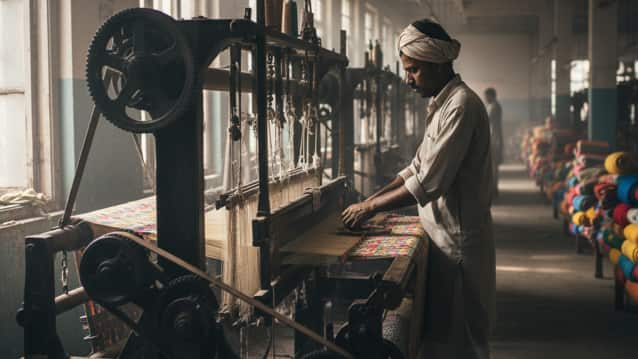India currently faces total tariffs of about 50 per cent on textile exports to the US, including a 25 per cent punitive levy, amid the absence of a formal trade deal between the two countries.

(Source: AI Image)
India’s textile industry witnessed a muted performance in the second quarter of FY26 as uncertainty surrounding US tariffs continued to weigh on exports, according to a report by Elara Capital. The report noted that the sector, which was earlier among the least affected by tariff measures, now faces the highest import duties among competing markets, posing a significant near-term challenge for exporters.
India currently faces total tariffs of about 50 per cent on textile exports to the US, including a 25 per cent punitive levy, amid the absence of a formal trade deal between the two countries. The industry expects that ongoing trade discussions could lead to at least the removal of the additional punitive component, but the timing remains uncertain.
Also read: Talking Tech: How Voice and Vernacular Are Powering India’s Next Digital Wave
To cushion the impact, the Indian government has taken several steps, including the removal of import duty on cotton until December and support for farmers through minimum support price operations. It is also advancing a production-linked incentive (PLI) scheme aimed at boosting fresh investments and competitiveness in the sector.
Meanwhile, New Delhi is focusing on signing free trade agreements (FTAs) with key partners to diversify export markets and reduce reliance on the US. After the India-UK FTA, talks are underway with the European Union and other nations. While the US remains a crucial destination for Indian textile exports, these upcoming trade pacts could offer partial relief in the longer term.
Despite the tariff headwinds, India’s market share in certain US textile categories has seen improvement. Between January and July 2025, India’s share in US towel imports rose 312 basis points (bp) year-on-year to 47.8 per cent, while its share in total apparel imports increased 65bp to 7.2 per cent. The share in cotton apparel imports also grew 128bp to 11.5 per cent over the same period. However, market share in cotton sheets slipped 130bp to 61.3 per cent.
Also read: 'Making Trade Credit Insurance a Guarantee Can Unlock India’s Trade Finance'
For Q2FY26, Elara Capital projects revenue growth of 4.4 per cent year-on-year and 4.7 per cent quarter-on-quarter across its textiles coverage universe, supported by higher garment volumes. However, capacity constraints in the yarn and fabric segments limited growth. Arvind Ltd is expected to lead the sector with 9.5 per cent YoY revenue growth, while exporters with greater exposure to the US market could see weaker results due to muted demand.
Average cotton prices declined 5.8 per cent YoY to Rs 154.5 per kg in the quarter, while yarn prices fell 1.9 per cent, improving the cotton-yarn spread by 4.8 per cent YoY to Rs 98.5 per kg. Sector-wide EBITDA is estimated to rise 4 per cent YoY, with margins remaining flat at 13.4 per cent. Vardhman Textiles is expected to post an EBITDA margin of 13.6 per cent aided by lower input costs, while KPR Mill’s margin may contract 123bp YoY to 18.8 per cent. Arvind’s EBITDA margin is likely to remain steady at 9.8 per cent, supported by strong performance in denim and garments.
Elara Capital maintained a positive long-term outlook for India’s textile sector, citing the country’s strong value-chain presence, cost advantage, and proactive government support.
Empower your business. Get practical tips, market insights, and growth strategies delivered to your inbox
By continuing you agree to our Privacy Policy & Terms & Conditions
